Early Timber Doors
Tony Barton
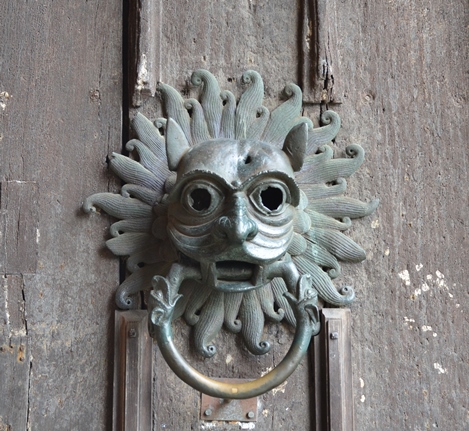 |
|
| The boarded main south door at Durham Cathedral with fillet mouldings and a replica of its original 12th-century bronze ‘Sanctuary knocker’ (Photo: Jonathan Taylor) |
The earliest timber doors encountered in the conservation of historic buildings are likely to be of a planked construction. Before panelled doors became the norm, from around the early 18th century, doors were made in various forms by joining together timber planks.
This article will explore the conservation of early hinged timber doors by focussing on the development of planked doors in Britain and the common issues encountered in their conservation.
OVERVIEW
Some of the first plank doors were hewn from a single log but as this was not practical for the largest doors, a method to join two or more planks together had to be found.
A double-plank door is the simplest and most sturdy construction and one of the earliest used in this country. It is made by joining together two layers of planks – vertical boards on one face and horizontal (or occasionally diagonal) on the other. In external doors, the vertical face is set to the outside because it sheds water more efficiently.
The earliest doors usually had two or three vertical planks but four-plank construction became common in the 17th century (the planks were not always of equal width). In some cases the planks would originally have been joined together using wooden pegs but in most surviving doors these will have been replaced at some stage with iron nails.
Nails were also used to bind the second type of door, the batten and plank door, in which the external vertical boards are held together with three or four horizontal ‘battens’, also known as ledges. The third type, the ledged and braced door, started to appear in the mid-19th century and used the same basic form as modern mass-produced doors. The drawing below illustrates these three basic forms but there are almost as many variations as there are surviving doors.
WOOD
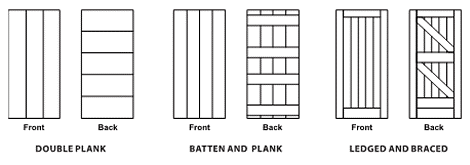 |
|
| The three principal types of early door (Drawing: Donald Insall Associates) |
Most historic timber framed buildings are oak-framed and although some chestnut is found, most of the joinery that survives from the medieval period was also cut from oak, often locally-felled.
Whether this is because less durable timbers have not survived or because this was the tradition is unclear.
The planks used in these sometimes intricate objects were hand cut directly from a felled log, a laborious and demanding task. It will also be obvious to those who have tried to use oak in new work, that avoiding warping and cusping of large oak boards requires a great deal of skill.
The planks used in early doors vary in width and depth. They are generally 25-32mm thick and may have a random variation in the width of the boards. To avoid additional cutting, carpenters probably used their varied stock of planks to make the desired door width. By the early 18th century, machine-driven sawmills were the norm and large timbers were rarer.
Wood, especially oak, will shrink and the joints become less weatherproof. Linda Hall (see recommended reading) writes that tongued and grooved planks have been found from as early as the 14th century and that rebated planks were common from the 17th century. Further enhancements include the addition of shadow mouldings cut into the planks for decorative effect. These early techniques later evolved into the panelled Georgian door.
DOUBLE DOORS
Many of the doors encountered in conservation work will be double doors, perhaps on a church or agricultural building. Larger doors may also contain a smaller access door or ‘wicket gate’, a door within a door that may be a later alteration in some cases. Some agricultural dwellings have doors with two leaves, one above the other, designed to let air and light into the interior and to keep animals out. The heads of the doors can be flat or cut to fit an arched opening, but it will be found that the same constructional principles apply.
BATTENS
Cross battens were fixed across vertical planks. Battens in earlier and humbler buildings were simple square-cut planks. In the 17th and 18th centuries the battens were often made with moulded profiles. In the utilitarian machine age of the 19th century the battens were simply cut at an angle to form a chamfer.
COVER FILLETS
Grander houses and churches often have applied timber mouldings over the vertical joints of the external doors. These cover fillets were designed to make external doors more weatherproof by covering the joints but they can also be seen on internal doors. They could be used to decorative effect, and their designs varied in form and profile according to region and historical period. Horizontal fillets were sometimes added to create the effect of panelling.
NAILS
Wood screws were not commonly used for architectural joinery until the 18th century when they began to be mass-produced. Planks, battens and fillets on earlier doors would originally have been joined together with nails. Once driven through fillet, plank and batten they were ‘clinched’ in place (flattened out on the inner side) with their points buried in the inner face to tie the timber together.
Nail heads were often left standing proud on the outer face of the door to add a rich texture and pattern. As a result, the number of nails and their arrangement often seem to go beyond what was needed to bind the door components together. The pattern might be articulated with further patterning on the external face in the form of scribed marks between the nails.
The heads were often chamfered. In his 1916 book, The Development of English Building Construction, Charles Innocent suggests that this form may have been modelled on the shape of the early wooden peg fixings (chamfering would have helped to drive the peg through).
IRONMONGERY
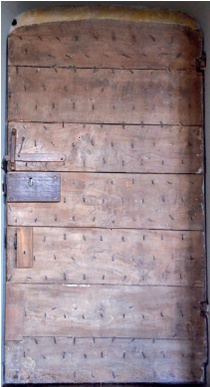 |
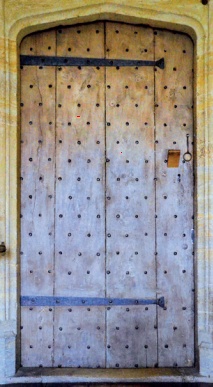 |
|
| The two sides of an early double plank interior door at Montacute House, mounted on simple iron pintles (Photo: Jonathan Taylor, by kind permission of the National Trust) | ||
The development of hinges, latches, bolts and other ironmongery is a subject in its own right and can only be touched on here. Timber and metal latches, bolts, stock locks and rim locks will all be found on early plank doors, and one of the conservator’s principal investigations should be to determine which are later additions and what they may have replaced. Holes and marks on the timber often provide evidence of earlier fittings.
Hinges are an integral element in the construction of doors. Before the introduction of iron strap hinges, the most common way of hanging a door was by pivoting it on a hard vertical post (the harr-tree) which formed one side of the door, and which was rebated into sockets (harrs) top and bottom.
However, most surviving early doors have wrought iron strap hinges. They may have been fixed in the outer or inner leaf, or both, and they may be set into the face of the planks and could be covered by the fillets. Early and vernacular examples simply had a loop at the hinged end which is hung on a pintle (an iron hook) set into the door recess or door frame.
FRAMES
In stone-built medieval houses and in more humble buildings of later periods, doorways rarely had timber frames: doors were hung on pintles driven directly into the stone rebate. A timber door frame would otherwise be set into the building’s structure and the joint between the frame and the wall was sometimes covered with a timber architrave.
FINISHES
Newly installed oak is paler and more natural in colour but turns grey as it ages and weathers. It is highly likely that during the door’s history it will have had more than one decorative finish applied. This might range from an early finish such as a lime-wash, oil or wax to a 20th-century paint finish, reflecting changing fashions.
CONSERVATION
To repair and adapt a historic door to modern circumstances one might apply the same principles for those developed for a complete building.
Obviously, doors are subject to more human attention and wear and tear than other elements. It is likely therefore that planked doors, as described above, will have had several repair regimes since they were first installed and have their own story to tell about the history of the building.
It is important, therefore, to gain as much information as possible about the doors. By taking a detailed look at them, carefully examining the way they have been put together, one may learn more than from any written account. As with the building as a whole, the doors are unlikely to be free from alteration and addition and an assessment must be made about the relative importance to the historical narrative of each layer of intervention. An informed judgement must be made about which ‘repairs’ have enhanced their architectural or historical significance and which have damaged the doors or detracted from the story.
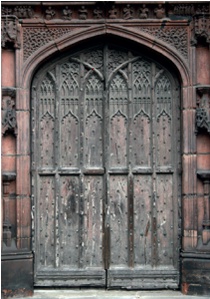 |
|
| A plank door at Chester Cathedral showing decay to the weatherboard, late filler repairs, additional bolts and later replacement timbers with a varnished finish (Photo: Donald Insall Associates) | |
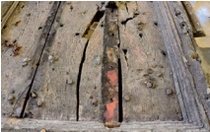 |
|
| Evidence of an old paint finish found after removing a cover fillet (Photo: John Nethercott & Co) | |
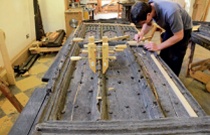 |
|
| New oak being spliced into old and a missing cover fillet being remade (Photo: John Nethercott & Co) |
Early timber doors are very likely to be part of a listed building, so listed building consent will be required for any alterations, and advice should be available from the relevant conservation officer or the national heritage body as well as from amenity societies such as the Ancient Monuments Society. If the building is scheduled, scheduled monument consent will also be required for all conservation work.
At the same time as considering the intrinsic values of the doors, a clear understanding of their structural and constructional integrity must be achieved. As can be seen from the description above, the early craft tradition developed to bind the whole leaf together, and to resist gravity and the lateral forces of opening and closing throughout its life. Integrity must be one of the principal concerns of the repairer.
Understanding how the doors were originally put together should underpin the approach to their repair. Measuring and drawing the door should be reasonably straightforward, noting evidence of past changes, and from this the original, current and possible future configuration of the various components can be determined.
Once an overall conservation-led approach has been established, the repair of the constituent parts can be considered.
TIMBER
Missing sections should be replaced in new timber. Normally this will be seasoned oak, chosen to match the grain of the original wood and pieced-in to follow the grain. The aim should be to make an attractive repair that is sympathetic with the original but which, upon inspection, can be readily understood as a repair.
With a skilled craftsperson on the team, timber affected by splits and shakes within individual timbers can often be consolidated by judicious use of reversible adhesives. The key is to repair each section of timber so that it becomes ‘more itself’ and to retain as much original fabric as possible. Care must be taken in the choice of glue because a modern epoxy resin may lack the flexibility required for normal use of the door.
BOARDS
The most common problem to be found in planked doors is the degradation of timbers at the base of the doors. The end grain of the planks is particularly vulnerable to the harmful effects of rainwater, splashing surface water and general damp, making it vulnerable to decay. Rotten plank sections should be cut back by the minimum feasible amount but new sections of timber will have to be fixed in place by mechanical means.
On a plank and batten door this would mean fixing the repair timber to (and therefore losing some material from) the lowest batten at the very least. Some carefully considered decisions may have to be taken because cutting back to the second batten to obtain a more secure fixing might be a step too far in removing sound and historically significant timber.
On external doors, one decision to make here is whether or not to add or replace a weatherboard to protect the base of the door. This is a sacrificial board placed at the base of the door to protect the area most vulnerable to decay. In some cases this board will itself be ancient, planted over or even replacing the lower section of the vertical boards. An assessment of its significance will inform the decision.
If whole battens or planks are missing, it should be relatively easy to determine the form of the replacement but no attempt should be made to artificially distress new timbers to disguise the repair. The art of the conservator is to produce a repair which is both aesthetically pleasing and ‘honest’.
Other key decisions will include how to make new mouldings adjacent to more weathered, older timbers.
METALWORK
As with replacement timbers, so new metal elements may be required. The nails and hinges should all be within the capability of a suitably skilled blacksmith and finding the balance between an honest repair and the overall visual integrity of the door is the challenge.
Regaining the original pattern of the clinch nails, if it can be accurately determined and re-made, using new nails of a similar form (but perhaps not exact replicas) to the original would go a long way to re-establishing the historical integrity of a door and its architectural significance.
FINISHES
There is no single answer to the question of what, if anything, to apply to a door once repairs have been completed. Careful examination of the surface and interstices will probably throw light on past finishes and it may be worth having these analysed by a paint specialist. It is more than likely that doors, especially the external faces, will have been painted at some time and analysis of any remaining fragments might provide evidence of earlier decorative and protective finishes.
Consideration of the overall conservation principles will also inform the approach to finishing the door. The exposure and vulnerability of the door to the elements, evidence of its found state, and whether or not a weatherboard has been added to protect the base will also be factors in this equation. If the conservation of the doors is part of a larger project, which may include remaking protection over the door opening itself, there may be less onus on applying a new finish. Sound, dry seasoned oak which isn’t subject to regular wetting in a non-marine environment may not need a new finish.
If there is clear evidence of a painted finish that has degraded in places, it may make sense to repaint the whole. A clear, natural tung oil or Danish oil might be an effective protective treatment and there are turpentine with beeswax recipes to research and try. The key point perhaps is to let the door ‘tell’ you what needs to be done.
MODERNISATION
The brief for the conservation of a door might include a requirement to upgrade its security, adding electronic devices such as alarm sensors, providing new ironmongery or a letterbox. Draughtproofing and weatherproofing would seem to be obvious considerations for the comfort of inhabitants and the conservation of energy.
Each door will present its own challenges but the overall historic and architectural significance of the door should determine the level of intervention. It should be possible to find a way to meet the needs of modern inhabitants, without affecting the integrity of an important door. Hopefully, imitation ‘period’ letterboxes or other inappropriate embellishments will be removed during conservation.
The most effective means of draughtproofing will be to repair the door and its frame, replacing any missing fabric, so that the original dimensions are restored and there is a snug fit. A new weatherboard could be fitted at the base and, if the floor is not too sensitive, a new metal weatherbar could be inserted into the floor below. It may also be possible to devise a subtle means of draught-stripping the door and frame.
Realistically, however, these post-medieval doors will never meet modern weather tight standards and the fact that many of these marvellous doors have a heavy curtain fitted to their inner faces shows that owners are happy to find pragmatic ways of living with this part of our shared history.
Recommended Reading
CF Innocent, The Development of English Building Construction, Cambridge University Press, Cambridge, 1916
L Hall, Period House Fixtures and Fittings 1300-1900, Countryside Books, Newbury, 2005



